Tag Archives: Craig Anderton
Mega-Modulate the Vocoder
I use vocoders all the time, but rarely for voice. One of my favorite techniques is using drums to “drumcode” synth pads or guitar power chords, and give instruments a drum part’s percussive qualities. This tip takes that concept to the next level.
For conventional applications, Version 6’s Vocoder inserts in the track that provides the vocoder’s modulation source (e.g., voice). Then, the audio you want to vocode comes into the Vocoder’s sidechain from a different track.
This tip’s goal is to use Impact XT’s individual drum outputs as separate modulation sources. For example, you could modulate the Vocoder with just the kick, or just the snare…or the snare and hi-hat…or all three, and vary the amounts in real time. The first audio example has only the “drumcoded” carrier, while the second audio example mixes in some of the original carrier sound. Both options are useful. (The carrier is Mai Tai, with the free CA Hard Sync.preset download from the 5 Mai Tai Tips & Tricks blog post.)
Mega-modulated drumcoded carrier.
Mega-modulated drumcoded carrier, with original carrier sound mixed in.
How It Works
Referring to fig. 1, the key to this technique is inserting the Vocoder in a Modulator Bus, not a Track. Then, send Impact’s individual outputs to the Modulator Bus. Because each output has its own fader, you can “mix” how much modulation you want each drum to contribute to the Vocoder.
Regarding the Carrier, to hear only the drumcoded sound, use a pre-fader send and turn down the carrier’s channel fader. Or, use a post-fader send, and mix in the desired amount of the original carrier with the channel fader.
Finally, for big-time, fader slammin’ fun, hook up a Faderport to control the Impact XT outputs. Now you can “play” the drumcoding in real time, and add some DJ-type thinking for a cool, live-performance vibe.
Version 1.3 of The Huge Book of Studio One Tips and Tricks is now available as a free update to owners of previous versions ($19.95 to new buyers). Download this 637-page book with 230 innovative tips from your PreSonus or Sweetwater account, the same way you downloaded your previous version. For more information, check out the series of Studio One eBooks. Please note: version 1.3 does not cover the new features in version 6, although there will be a free update in the future. If you have questions about the tips, suggestions for future updates, or want news about the next version, please visit the dedicated support forum.
Ultra-Easy Mid-Side Processing with Artist
A previous Friday tip, Mid-Side Processing with Artist, was published in June 2021. Since then, I’ve found a less obvious, but simpler away to accomplish virtually identical results.
To simplify, mid audio is what’s centered in a stereo track. Sides audio is what’s panned off to the sides. This tip extracts a stereo audio track’s mid audio to one console channel, and the sides audio to a second console channel.
Once extracted, you can process each element separately. This can be as simple as changing the balance between the mid and sides, or as complex as adding signal processors (like reverb to the sides, and equalization or delay to the mid). A common technique is increasing the sides level to widen the stereo image.
Obtaining the Mid and Sides
The mid is simply both channels of a stereo track panned to center. So, the mid also includes what’s in the right and left sides, but the sides are at a lower level. This is because anything the left and right channels have in common will be a few dB louder when panned to center.
The sides first reverses one of the stereo channels before mixing them into dual mono. So, whatever the two channels have in common—namely, the mid audio—cancels out. Following the dual mono signal with a second phase reversal restores the signal to stereo, and corrects for the original phase change.
Fig. 1 shows the setup for how to extract the mid and sides audio from a stereo console channel.

How to Extract the Mid Audio
The Mid pre-fader send from the Stereo Audio track feeds the Mid console channel. Set the send level to 0.0. The Mid console channel includes a Dual Pan. Select the Dual Pan’s Mono preset. This is all that’s needed to extract the Mid audio in the Mid console channel.
How to Extract the Sides Audio
This extraction process is a little more complex. The Sides pre-fader send from the Stereo Audio track (also set to 0.0) feeds the Sides console channel. The first Mixtool inverts the right channel. For the Dual Pan plug-in that follows the Mixtool, again choose the Mono preset. (You want both Dual Pans to use the same pan law.) Because the right channel is out of phase, the Dual Pan’s mono output cancels any audio the left and right channels have in common. This produces the sides audio.
To convert the sides audio back to conventional stereo, the second Mixtool inverts the right channel’s phase. Now, the sides are extracted, in stereo, and in phase with each other.
Mixing with Mid and Sides
With this method, you’ll need to mix the mid and sides level individually:
- Set the Stereo Audio track to minimum. The sends are pre-fader, so this won’t affect the send levels.
- Edit the mid audio level with the Mid channel’s level.
- Edit the sides audio level with the Sides channel’s level.
- To process the Mid or Sides, insert plug-ins after the existing console channel plug-ins.
When the Mid and Sides balance is correct, group the two console channels. To do this, select the two tracks and type Ctrl+G. This also gives you the option to name them. Now you can set both levels by moving either fader.
MIDI Guitar: the V6 Remix

The May 2021 Friday Tip described how to use Jam Origin’s MIDI Guitar 2 software with Studio One 5 running on Windows. Unlike the Mac, Windows doesn’t support virtual MIDI ports natively. So, the tip described a workaround of running Jam Origin in standalone mode, and using Tobias Erichsen’s loopMIDI virtual MIDI cable to connect it with Studio One.
Although Melodyne Essential can also translate guitar audio to polyphonic MIDI data, it doesn’t work in real time, track pitch bend, or have features like legato response. However, V6’s instrument track enhancements eliminate having to do any kind of workaround with MIDI Guitar 2, and improves the overall performance.
How to Do It
1. Add a mono audio track for your guitar, and assign its input to your guitar’s audio interface input. Set the track’s input Monitor to on.
2. Insert the Jam Origin MIDI Guitar 2 plug-in into the guitar track.
3. Create an instrument track with your instrument of choice. Mai Tai is my go-to for MIDI guitar, but any VST3 or VST2 instrument I’ve used so far works.
4. Assign the instrument track input to MIDIGuitar2-64bit (fig. 1).
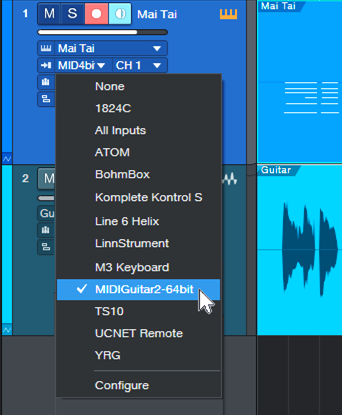
5. Start recording. I recommend recording the guitar track and the Instrument track. Processing the recorded guitar track, like using a gate or expander, can create some interesting results when driving the instrument. Also, sometimes lowering the clip level improves the conversion to note data.
6. When it’s time to edit the Instrument track’s note data, make sure to set the Instrument’s MIDI input to None (or, delete the guitar track). Otherwise, the instrument will be triggered from both the note data and the original audio data.
And Speaking of Editing…
You always need to clean up MIDI guitar parts to some extent, but some mass operations can save time. Select all the part’s notes, then remove notes with ultra-low velocities and ultra-short note lengths (fig. 2). Note that you need to do this as two separate passes, otherwise you’ll delete only notes that have both low velocities and short lengths.

Even better, a Macro that deletes ultra-low velocity notes can save a lot of otherwise detailed editing. To create a new Macro that does this:
1. After creating the new Macro, add Musical Functions | Select Notes
2. Double-click on the command, and choose Select and Range. Then, specify Velocity from 1% to 50% (or whatever velocity works best for your playing style and guitar level).
3. Add Musical Functions | Delete Notes
Using a Macro to clean up ultra-short, unintended notes is more fraught, because MIDI Guitar 2 will pick up the transitional notes that happen when you slide from one chord to another. These can be quite short, and I usually want to keep them. So, I select all notes, choose Delete Notes, and start with very short values (like 0.00.10). That deletes some undesired notes. I’ll then repeat with a longer value, like 0.00.20. There’s usually a value that gets rid of notes you don’t want, but keeps the transitional ones.
Of course, you can be less concerned about deleting longer note lengths if you’ll end up quantizing the notes anyway, and just want to delete any notes that are shorter than desired.
Further Optimization
MIDI guitar is never perfect, but given that Jam Origin works polyphonically with guitar audio and requires no special hardware, it’s pretty amazing. MIDI guitar opens up other advantages, like using Note FX, and altering the Chord Track to create more adventurous chord progressions. For further advice about optimization, see the original tip referenced at the beginning, and also check out the documentation on the Jam Origin website.
Faster, Simpler Plug-In Parameter Control

You’re probably familiar with Studio One’s Micro Edit view, where you can expand/collapse an effect in the Insert Device Rack. However, Studio One 6 extends this ability to third-party plug-ins. You can treat the Insert Device Rack as your plug-in GUI, and tweak or write automation for parameters without having to open a plug-in’s interface. The Micro Edit view is ideal for quick tweaks, but also, for effects that interact with each other, like EQ and compression. Instead of having to bounce back and forth between two different plug-in UIs, all the necessary parameters are laid out in front of you.
Fig. 1 shows an example of using a Micro Edit view in the master bus. The processors are Waves’ UM226 stereo-to-5.1 surround upmix plug-in, followed the IK Multimedia’s Stealth Limiter as a post-master fader effect. Although the UM226 is designed to synthesize surround, I also use it as a “secret weapon” to give more of an immersive feel, and sense of space, to stereo mixes. Its UI is relatively large, so this lets me tweak it while doing a mix with other plug-ins open. Micro Edit view lets you choose the parameters you want to include from third-party plug-ins. The ones shown are the ones I edit most often.

You can choose as many or as few parameters as you want, and all of them are automatable. However, also note that the standard automation options don’t have to overlap with these parameters. For example, I use standard automation for switched functions that might only be needed to change once or twice during a song. There’s no need to have them take up space in the Micro Edit view.
Serious Micro Edit Automation
Opening the view in the Insert Device Rack limits the fader length. That’s okay for tweaking parameters, but for automation, it’s better to have a longer fader. Version 6’s Channel Overview takes care of that (fig. 2).

Assigning Parameters
With PreSonus plug-ins, Micro Edit View parameters are pre-assigned to the most-used functions. With third-party effects, you select the Micro Edit view parameters, similarly to how you choose automation parameters.
Right-click on the effect name in the Insert Device rack, and choose Setup Micro Edit Parameters. Click on the parameters you want to add in the right pane, and choose Add. Now the parameters will be in the left pane, and visible as Micro Edit view parameters.
Fig. 3 shows how this can save a huge amount of screen real estate when mixing. The Ampeg SVT suite bass plug-in’s UI takes up a lot of space. So, I assigned all the parameters for the amp being used to Micro View parameters. Now tweaking the parameters simply requires expanding the Micro Edit view, and collapsing it again when done (expanding and collapsing are both one-click operations).
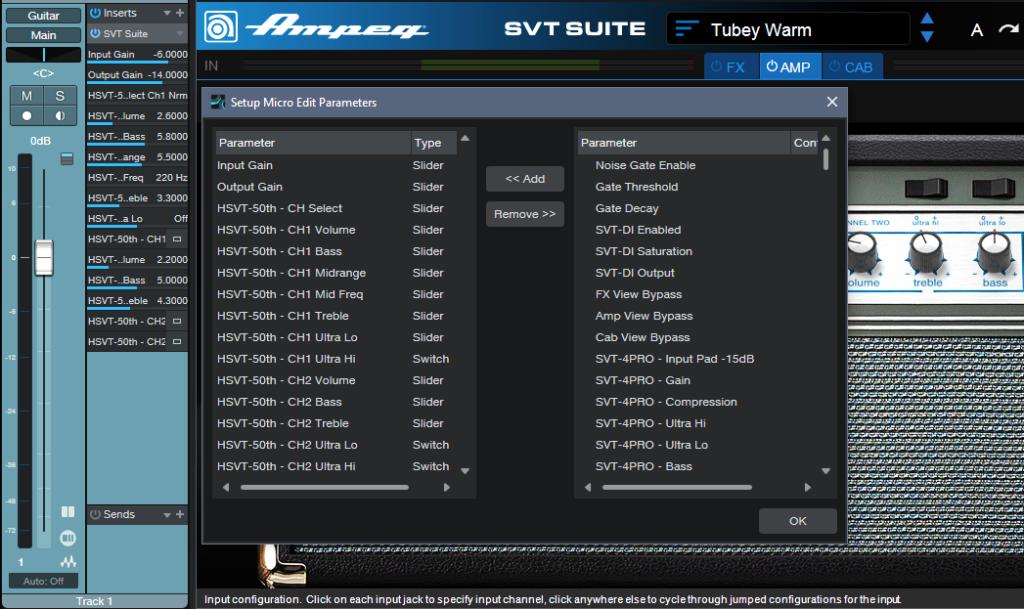
This is the kind of feature that may not seem like much of a big deal—until you start using it. Micro Edit view makes for a less cluttered, more compact, and visually streamlined mixing experience.
Heads-up: Version 1.3 of The Huge Book of Studio One Tips and Tricks is now available! This 637-page book with 230 innovative tips is a free update to owners of previous versions ($19.95 to new buyers). Download the update from your PreSonus or Sweetwater account the same way you downloaded your previous version. For more information, check out the series of Studio One eBooks. Please note: version 1.3 does not cover the new features in version 6, although there will be a free update in the future. If you have questions about the tips, suggestions for future updates, or want news about the next version, please visit the dedicated support forum.
Plug-In Matrimony: Pro EQ3 Weds Dynamics

Studio One’s Pro EQ3 represents a major evolution to the Pro EQ. It now incorporates dynamic EQ, effectively but unobtrusively—if you want, you can treat EQ3 just like you did EQ2. Another addition is solo buttons for individual bands. This is useful with standard EQ, but is particularly useful with dynamic EQ.
Dynamic EQ Basics
Dynamic EQ boosts or cuts over a specific frequency range, like standard EQ. However, the boosting or cutting doesn’t occur until the audio in that frequency range crosses over a threshold. The higher the audio level is compared to the threshold, the greater the amount of boost or cut.
De-essing is a basic example of dynamic EQ. High-frequency “ess” sounds aren’t processed unless they exceed a threshold. When they do, the dynamic EQ cuts the response in that range. The stronger the ess sound, the greater the attenuation. Another example is attenuating excessively loud cymbals if they exceed a threshold.
Superficially, dynamic EQ may seem like multiband dynamics. Both combine dynamics processing and equalization. However, multiband dynamics processors use crossover filters to split the incoming audio into multiple, fairly broad bands. The EQ3 processes frequencies with the precision of its usual peaking and shelf EQ stages, using as many or as few stages as needed.
A more technical difference is that crossover filtering is fairly drastic. This introduces phase shifts, unless a multiband dynamics processor uses linear-phase filters. Dynamic EQ is less likely to require super-drastic settings, which minimizes potential phase shifts.
Let’s Get Dynamic!
To use Studio One’s Pro EQ3 for dynamic EQ processing:
- Click the Dynamics button toward the EQ3’s top. This reveals Threshold and Range controls for the parametric/shelving stages.
- Check that the Curves button is enabled, so you can see the curves that the dynamic EQ stages generate.
- Click a stage’s D button to enable its dynamic equalization response.
The display unambiguously shows how dynamic EQ processes the sound. The white curve is the usual curve that shows a stage’s amount of boost or cut. Varying the Range parameter adds a second curve. It uses the same color as its associated EQ stage. This curve represents the maximum amount of gain change that can occur once a signal exceeds the threshold.
Let’s look at a practical example. A 500 Hz sine wave from the Tone Generator feeds the Pro EQ3 MF peaking stage, which is set to 500 Hz.
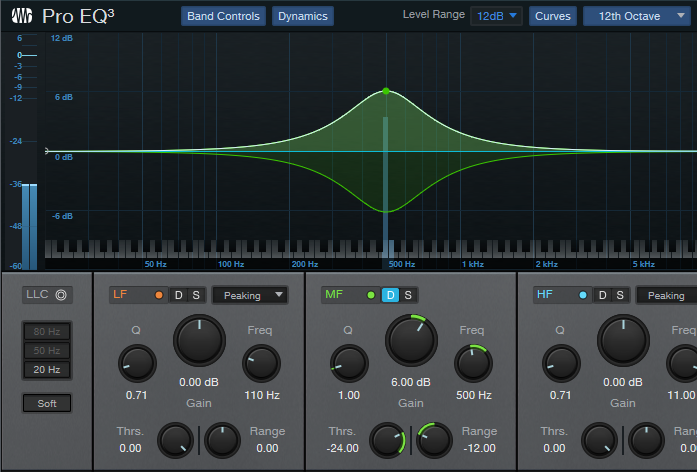
In fig. 1, according to the meter on the right, the input signal is at -36 dB. This is below the dynamic EQ stage’s threshold (which is -24 dB), so the EQ is not affected. The white curve shows that the EQ is applying 6 dB of gain at 500 Hz, just like a standard EQ stage.
The green curve graphically shows the available range of dynamic processing, as specified by the Range control. Range is set to -12 dB, and the curves confirm this—the range from the current +6 dB of gain to the maximum ‑6 dB cut is -12 dB.
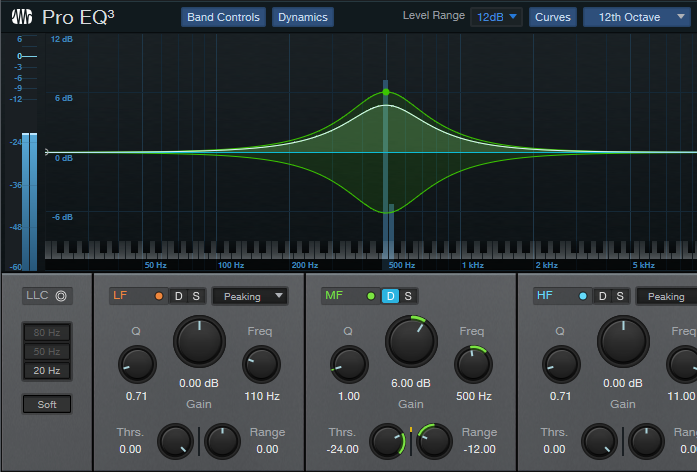
In fig. 2, the input signal is now above the -24 dB Threshold. Because the Range value is negative, audio above the threshold reduces the EQ’s gain. The white line has now moved downward to show that the EQ’s gain is no longer 6 dB, but has been pushed down because the input signal is above the threshold.
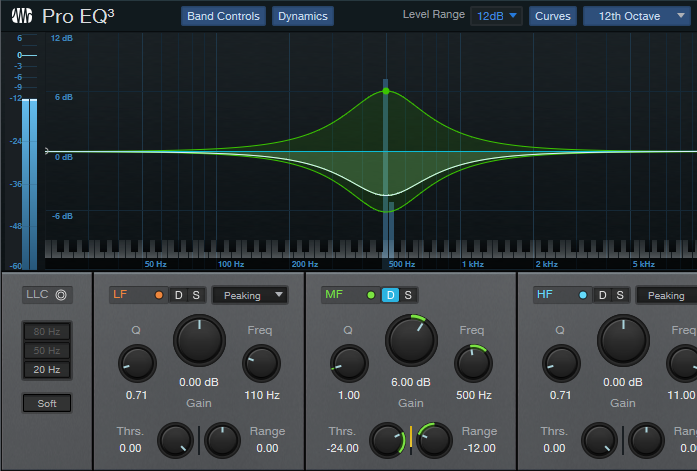
In fig. 3, the input is just under -12 dB. This is almost at the maximum available negative range. The white curve shows that the EQ stage has gone from a boost to a substantial cut. Also, note the yellow bar meter to the left of the Range knob. This displays the reduction amount.
That’s really all there is to understanding dynamic EQ—in future tips, we’ll get into practical applications.
Heads-up: Version 1.3 of The Huge Book of Studio One Tips and Tricks is now available! This 637-page book with 230 innovative tips is a free update to owners of previous versions ($19.95 to new buyers). Download the update from your PreSonus or Sweetwater account the same way you downloaded your previous version. For more information, check out the series of Studio One eBooks. Please note: version 1.3 does not cover the new features in version 6, although there will be a free update in the future. If you have questions about the tips, suggestions for future updates, or want news about the next version, please visit the dedicated support forum.
Related: Here’s Gregor taking a closer look at ProEQ3 in action, as well as the other new plug-ins in Studio One 6!
Five One-Stage EQ Fixes

These simple EQ settings can fix a variety of issues. Just remember that often, a little goes a long way. When boosting or cutting with EQ, try the “rule of half”—boost or cut by what you think is the correct amount, then cut it in half and live with the sound for a while before deciding you need more.
1. Magic Fairy Dust

This trick dates back to the days of tape, when multitrack projects would start to lose high frequencies due to constant playback and self-erasure. Adding some high-frequency spice on the stereo mixes or masters helped compensate for any dullness. Although we don’t need to add as much compensation with DAWs, a somewhat narrow, moderate boost at 10 kHz (fig. 1) adds sparkle and brightness that gives a sheen to cymbals, percussion, and even vocals.
2. Clean Out Mud from Your Reverb

This is especially useful for drum reverb. Reverberated kick can produce a muddy, indistinct sound that interferes with clarity in the bass range. Rolling off some low frequencies (fig. 2) prior to going into reverb eliminates the mud, and tightens the reverb. Note that you don’t need to use the linear-phase EQ for this application, because it doesn’t matter if there are some phase shifts about the cutoff frequency—it’s just going through reverb anyway. Also, if your CPU is straining, you don’t need to use the Pro EQ2’s High Quality mode.
3. Make Vocals More Intelligible
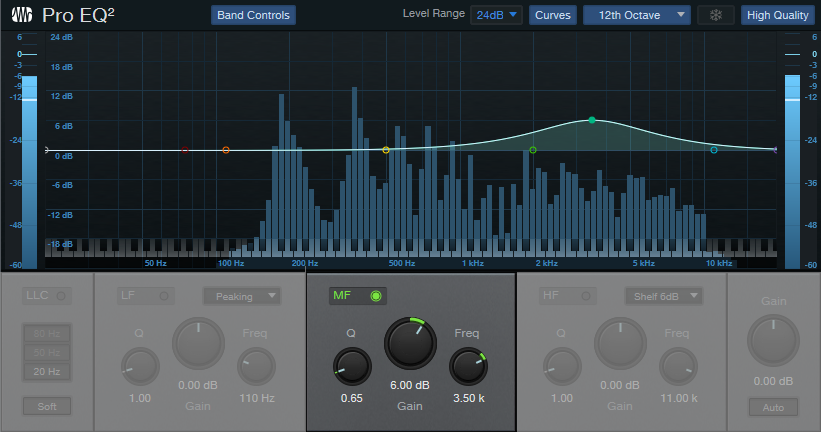
This tip applies not just to singing, but to narration, voiceovers, and podcasts. A fairly broad boost in the 3 to 5 kHz range (fig. 3) increases intelligibility and adds brightness that helps lift a vocal in the mix. The optimum frequency depends on the voice and mic, but don’t overdo the boost. The human ear is most sensitive in this region, so too much boosting leads to listener fatigue—and you don’t want listeners to get tired of your vocals.
4. Tighten Your Master

For a brighter, tighter pop sound when mastering, a slight dip in the 250-300 Hz region (fig. 4) reduces any potential muddiness. This can occur because many instruments have energy in this region, which unbalances the sound. Again, though, you be sparing. This region also contributes “warmth” to the sound, and you don’t want to reduce that too much.
5. Selectively Push Frequencies into Processing
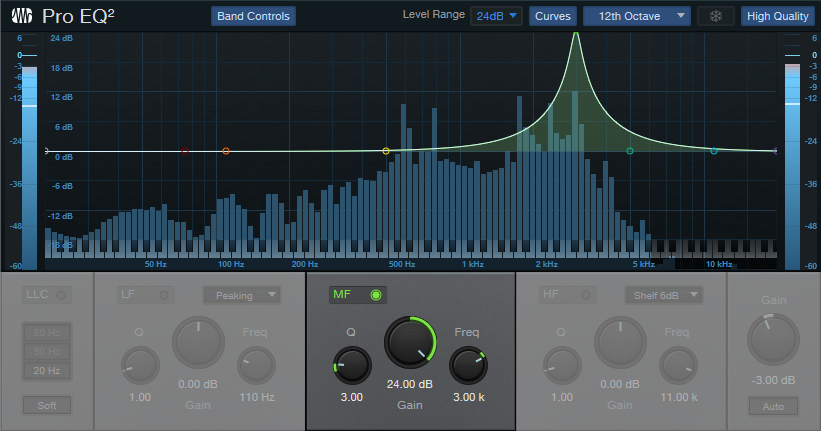
This tip is most relevant with dynamics processing and amp sims. The sound of dynamics processors depends on whether audio goes above a threshold or not, while amp sims depend on a signal level being high enough to go into distortion.
Fig. 5 shows settings that precede an amp sim set for lead sounds. With these settings, the guitar’s high notes go into distortion more readily than low notes. The lead notes sustain longer, and you don’t have to hit the strings as hard to get the same amount of level as the lower strings. Although this goes against the conventional wisdom of placing EQ after compression, we’re using the EQ to modify the subsequent effect, not specifically to change the tone. Besides, conventional wisdom is overrated 😊
Heads-up: Version 1.3 of The Huge Book of Studio One Tips and Tricks is now available! This 637-page book with 230 innovative tips is a free update to owners of previous versions ($19.95 to new buyers). Download the update from your PreSonus or Sweetwater account the same way you downloaded your previous version. For more information, check out the series of Studio One eBooks. Also, there’s a dedicated support forum if you have questions about the tips, or suggestions for future revisions.
Two Crucial Tips for Quantizing Rhythm Guitar

Quantizing audio works best with short, percussive sounds—like drums. Rhythm guitar is more of a challenge, because the attacks aren’t always defined well, and volume fluctuations can add spurious transients as a chord decays. I know quite a few guitarists who set up their quantize parameters, hit “Apply,” and then wonder why the guitar part sounds worse, not better. So, they hit “Undo” and assume quantizing doesn’t work well for guitar. But it can, if you know the two tips in this week’s blog post.
To start the quantization process, select the event, open it in the Edit view, right-click on it, and choose Detect Transients. Do not choose Quantize, because we’ll need to edit some of the transient markers prior to quantizing. Then open the Audio Bend panel. The default transient detection is Standard analysis, with a Threshold of 80% (fig. 1). These are good initial settings for guitar.

Tip #1: First, Do No Harm
With complex chords and lots of strings vibrating, Studio One may dutifully identify each attack with a transient marker. However, when listening, you might not hear any attacks in those places. Applying quantization to places that don’t need to be quantized can degrade the sound.
In fig. 2, after playing back the part, it didn’t seem the markers colored red (top view) needed to be there—only the marker between the two chord attacks correlated to an audible transient.

Quantizing with all the markers in place created awkwardly stretched audio (middle view). After removing the markers in red and quantizing (bottom view), the quantization occurred exactly as desired.
Bottom line: If a transient marker doesn’t correlate to a transient you can hear, you’re probably better off deleting it. Sometimes, lowering the Threshold percentage in the Audio Bend panel takes care of removing unneeded markers for the entire Event.
Tip #2: Simplify Double Attacks
This is a big problem with rhythm guitar, because it’s physically impossible to hit all 6 strings at the same time. In fig. 3’s top view, note the doubled attack just before 3.4 (one of the attacks is colored red for clarity).

The middle view applies quantization. Studio One has dutifully shifted the two transients to 16th notes, as instructed by the quantization parameters. But this overstretches the audio between the two transients, and doesn’t sound good.
The bottom view shows the audio after removing the transient shown in red in the top view, and then applying quantization. Studio One has shifted the remaining attack transient to the nearest 16th note, which is what we want.
Here’s another tip that relates to fig. 3. Note how the quantized transients at 3.4 and 4 seem a little late, like they missed the first part of the attack. However, I’ve found that if Studio One doesn’t have to deal with double attacks, it makes good judgment calls about where to define the chord’s attack. I’ve tried placing the transient closer to where the attack starts and quantizing, but most of the time, the chord then sounds a little late. Trust the force.
In any case, a little manual tweaking prior to quantization can make the difference between a natural-sounding part that doesn’t seem quantized, and quantized audio with unwanted glitches. I never quantize a rhythm guitar part without looking over the transients first, and making sure they don’t exhibit any of the issues described here.
Magic Stereo

For me, the gold standard for sound isn’t what comes out a studio, but live music. One of the reasons is that mono sound does not exist in an acoustic environment—it’s always interacting with the acoustic environment.
Sure, we can add reverb to give a mono instrument like electric guitar a static position in a stereo field. However, that will always require some kind of time-based manipulation. For a recent song project, I wanted a background guitar part to have motion within a stereo field—but without using any kind of delay, reverb, panning, or EQ. In other words: dry, electric, mono-output guitar with a stereo image. Impossible? Let’s find out.
The Track Setup
The way this works is so simple I’m surprised I never figured it out before. Fig. 1 shows the track layout. The guitar (with added chorus, as required by the song) pans full left, and has two sends. One send provides the guitar’s audio to a bus. The other send controls the sidechain of a Compressor inserted in the bus. The bus is panned full right.
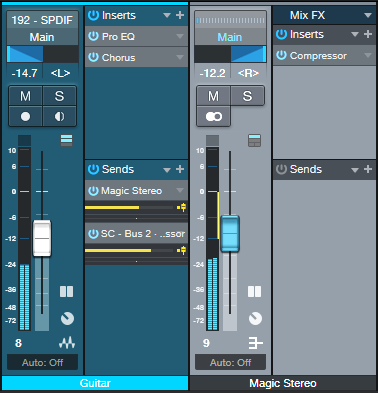
As the Compressor’s level changes, there’s a sense of motion as the dynamics and levels in the left and right channels change. Even better, these changes are tied to the instrument’s dynamics. This makes for a more natural effect.
This audio example plays the guitar by itself, panned to center, and going through the PreSonus chorus.
Now let’s hear the magic stereo effect. Although it’s most obvious on headphones, you’ll hear the effect on speakers as well.
The final audio example plays it in context with the mix. It adds a sense of animation to the guitar you can’t get in any other way. I also included this example because the drums are following the chord track. It has nothing to do with this tip, but I love the cool melodic quality it adds.
Compressor Settings
The Compressor settings are crucial. The ones shown in fig. 2 are a good place to start.
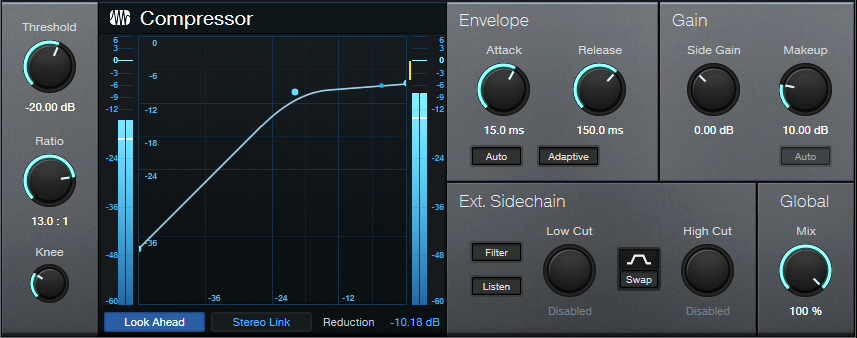
Adjust the settings by panning the source track full left. Increase the processed track’s level until both channels are at about the same level. Experiment with the Compressor’s Threshold to find the sweet spot between the compressor having no effect, or having too much of an effect. The Release can also affect this—too short or too long a release neuters the effect. You’ll likely have to readjust the processed channel’s level quite a bit as you zero in on the ideal settings.
With 15 ms Attack, both channels have their attacks hit at the same time and with the same intensity. So, the attack sound appears in the center, has the advantage of center-channel buildup, and helps anchor the part. As the audio decays and the channels are more dissimilar, the audio “wanders” more in the stereo field.
This technique is also great with background vocals. I didn’t use it in this song because there was so much motion going on overall I wanted the background vocals to be a constant. However I’ve used this technique with other songs, and it’s very effective—especially if you have multiple tracks of background vocals, and you apply individual magic stereo processing to each one.
Instant Inspiration!

The MIDI-oriented Songwriter’s Assistant tip makes it easy to play around with chord progressions. This new tip is about experimenting with, and recording, audio chord progressions in real time—keep the sections you like, discard the rest, and build your song from there. It’s a simple, eight-step process.
1. Start with an empty Song. Enable the Chord Track, then use the Paint tool to create a Chord Track that runs the length of how long you expect to be trying out different chord progressions. The chord itself doesn’t matter.
2. Double-click on the Chord Track, then enable the Chord Selector’s Instrument Input and Speaker buttons (fig. 1).
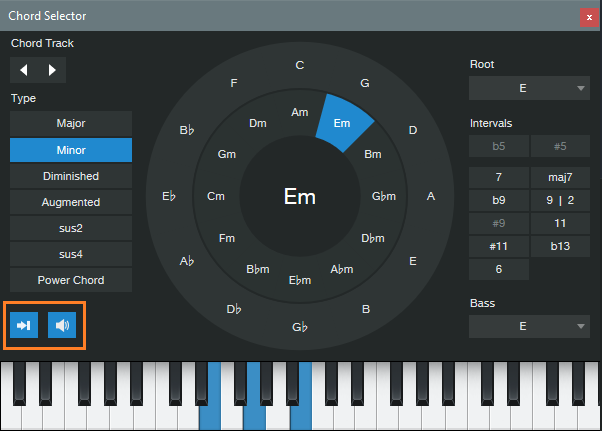
3. Create a stereo audio track. Assign its input to Instruments > Chord Preview, and record-enable it. We’ll call the track Chord Progression (fig. 2).
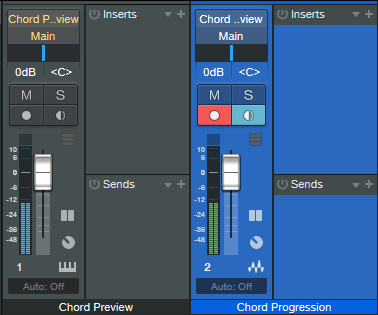
4. Click on the Instrument Editor button in the Chord Preview mixer channel to open Mai Tai. This is the sound used for the Chord Track preview. For this tip to work correctly, it’s crucial to make the edits in fig. 3 to the Chord Preview preset. (After making the edits, I overwrote the original preset.)
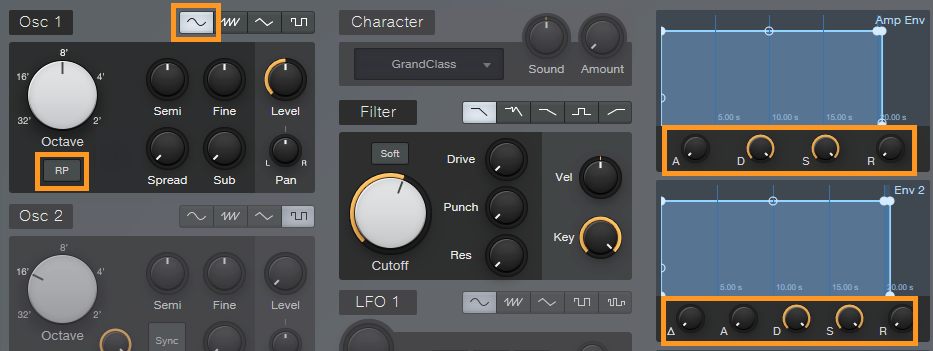
5. At this point, you’ll usually enter a rough tempo (you can always tweak the tempo later), enable the metronome, and select a 1-bar precount.
6. With the Chord Selector visible, start recording in the Chord Progression track. Click on a chord in the Chord Selector (however, the first chord must be different than the one that’s currently selected) to record its sound into the Chord Progression track. Continue selecting chords to create various chord progressions. Note: the chord will play for only a finite amount of time after you click on it, and it won’t play if you click on it again. To extend a chord’s playback, my workaround is to alternate clicking between the original chord and Power Chord (under Type).
7. Some of the progressions you try might be useful, some might not be—no problem. Keep the chord progressions that work, delete the rest, move them around on the timeline…whatever.
10 . At this point, you’ve probably forgotten which chords you played and when. Right-click on the recorded Event, and choose Audio > Extract to Chord Track. This automagically shows your chord progression (fig. 4). You may need to do a little cleanup, like extending a chord over where there’s silence—but your song is on its way.
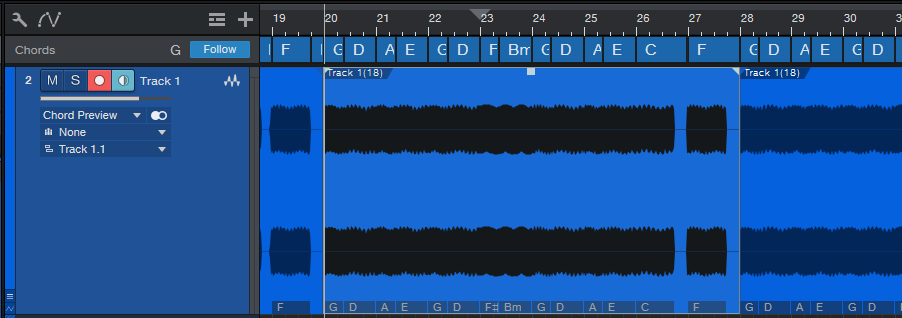
If you extended a chord’s length by using the workaround described in step 6, when you extract to the Chord Track, the chord extends for the time you clicked between the chord and Power Chord. Furthermore, it retains the chord type. For example, if you click on Dm, Power Chord, Dm, Power Chord, Dm, all of those will be represented as a single Dm chord “bar” in the Chord Track when extracted. Nice.
Now you can record other parts on other tracks, and have them follow the Chord Track. And here’s an extra tip: Read over the Chord Track documentation when you get a chance, and re-visit my previous Chord Track tips—the Chord Track is an incredibly powerful feature.
Heads-up: Version 1.3 of The Huge Book of Studio One Tips and Tricks is now available! This 637-page book with 230 innovative tips is a free update to owners of previous versions ($19.95 to new buyers). Download the update from your PreSonus or Sweetwater account the same way you downloaded your previous version. For more information, check out the series of Studio One eBooks. Also, there’s a dedicated support forum if you have questions about the tips, or suggestions for future revisions.
Instant Soundtrack!

Who reading this wouldn’t want to make a little more money from their music? Okay, dumb question.
When people think “soundtrack,” images of Hollywood scoring stages come to mind. But soundtracks are a much broader topic now. YouTube videos, podcasters, corporate presenters, educational videos, and local businesses doing radio or TV ads all need soundtracks.
In 1992, I wrote an article called “Subtractive Sequencing” for Keyboard magazine that described filling a piece of music with loops, and then cutting out sections to make an arrangement. It didn’t get much attention. But over 20 years later (!), a blog post called “Subtractive Arranging—Novel Production Method from Danny J Lewis” presented the same technique. This time, it did get attention, to the point where the inevitable “Why I Don’t Use Subtractive Arranging” appeared in someone else’s blog.
Why? He didn’t like how this technique created static arrangements. But those “static arrangements” are actually ideal for… wait for it… soundtracks.
A good soundtrack fills space behind visuals or narration, but always plays a supporting role. So, I use subtractive arrangements to create soundtracks. I just take a song, and remove anything with a human voice, lead lines, some of the layers in layered parts, and most ear candy unless it complements the visuals (fig. 1). Then I render the mix, and compress the heck out of it—not to win the loudness wars, but to maintain a constant level that can happily sit -12 to -15 dB or so below the narration or dialogue.

In fig. 1, subtracted events are filled in with white for clarity. The tracks Lead Vocal and Smile (some ear candy) were muted. So was a layered, Nashville tuned guitar track, because the high frequencies stood out too much. The layered Standard tuning part was left in, but extra tempo-synched echo for both were cut. Similarly, there were two tracks of “Beat Filters,” loops from my AdrenaLinn Guitars loop library. They were panned to center and side for a cool stereo effect—that no one would care about. So, I muted one of them. Sections of a house bass loop were also removed.
The final, mixed soundtrack is exactly 1.5 minutes, and consists of drums, rhythm guitar triggered by a drum sidechain signal, bass in some parts, a beat filter loop in some parts, and a little acoustic guitar. That’s all that was needed. One last tip: You can mix bass up pretty high, because it helps drive a song and is out of the speech range.
Every now and then, I go through some of my older projects, strip out anything distracting, create a soundtrack, and save it into my “Soundtracks” folder. Whenever I need a soundtrack, there’s always something suitable in there. And even better, if you get into creating soundtracks, you might find some interesting opportunities to make money from them.
Here’s the finished soundtrack:
For more tips on how to get the most out of Studio One, check out the series of Studio One eBooks that cover tips & tricks, creative mixing, recording/mixing vocals, dynamics processors, and recording/mixing guitar. Remember, just like software, eBook owners can download the latest “point” updates for free from their PreSonus account (or Sweetwater account, if purchased from there). Owners are also eligible for new editions at a reduced price.
